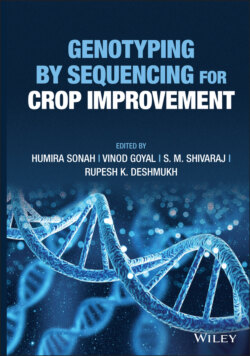Читать книгу Genotyping by Sequencing for Crop Improvement - Группа авторов - Страница 59
3.1 Introduction
ОглавлениеRecent advancements in next‐generation sequencing (NGS) have speed up genomics and transcriptome research across the board, especially in plant science (Rana et al. 2019; Ratnaparkhe et al. 2020). Genomics is a key for the better understanding of whole‐genome involving the DNA sequences determined in the order in which they are present in a genome which indeed in the sequential exploration of the evolution of genome structure and interpretation of the molecular phylogeny. It involves the combination of various technologies including recombinant DNA, sequencing methods of DNA, and bioinformatics to assemble, analyze and assign the structure and function of the plant genome. Earlier, the Sanger method was commonly used for nucleic acid sequencing in genomics but in 2005 the development of NGS brought sequencing platforms that are fast and cost‐effective enabling the excavating of characteristics unique to particular species in terms of gene structure as shown in Figure 3.1 (Unamba et al. 2015; Loera‐Sánchez et al. 2019). It also enables us to understand the mechanism lying behind the process of gene expression as well as secondary metabolism. Further recent advances in the NGS platforms bring the gratifying efforts in de‐novo whole‐genome/transcriptomic sequencing and also for the developments of markers based on genome‐wide sequences (Vasupalli et al. 2020). The most common platforms of NGS include Illumina/Solexa, ABI/SOLiD, Helicos, and 454/Roche (Unamba et al. 2015).
Earlier techniques for gene expression analysis include northern blotting in which specific RNA are detected and quantified (Goda and Minton 1995). Another technique involves the hybridization of antisense RNA with the complementary known target sequence thereby preventing the digestion of target sequence by single‐strand RNAase resulting in the specific and accurate quantification of the target sequence. But the major drawbacks associated with this technique include it requires prior knowledge about the target sequences. With the advancements in technologies, transcriptomics came into existence which analyses all RNA molecules (tRNA, rRNA, mRNA, and other noncoding RNA) transcribed in an organism. Microarray is a widely employed technique to analyze the transcriptome. In a single experiment, this technique can measure the expression level of a thousand genes but there are several issues associated with its sensitivity and reproducibility.
Figure 3.1 Diagrammatic representation of various high‐throughput‐sequencing methods used in assessments of genetic diversity. Methods mentioned in grey oval represent the complexity reduction. Library preparation steps are indicated by plus sign. Red arrow indicates reduced representation libraries produces by starting DNA sample digestion with restriction enzyme. Orange arrow indicates amplicon sequencing while blue arrow represents the sequence capture. Whole‐genome resequencing is indicated in purple arrow in which random fragments of digested DNA are sequenced. Green arrow represents plastid genome skimming responsible for plastid genome sequences recovery.
The figure is reproduced from Loera‐Sánchez et al. (2019) which is available under a Creative Commons Attribution 4.0 (CC‐By 4.0) International License, which permits reproduction.
The recent advancement in NGS includes next‐generation RNA sequencing (RNA‐seq) (Sharma et al. 2011; Sonah et al. 2016). This technique mainly focuses on the mRNA sequencing of only those genes that are expressed in the transcriptome (Chaudhary et al. 2019b). This technique helps in the identification of novel genes by de novo assembly without reference genome mapping. NGS also aids in the development of molecular markers. NGS has led to the exploration of thousands of markers on the entire genome resulting in an ease in the genome‐wide association studies. These markers also aid in association mapping (Sonah et al. 2015; Zargar et al. 2015). These technologies have enabled us to understand the underlying process of gene expression and the development of resources for the analysis of marker‐assisted breeding (MAS) and diversity analysis (Unamba et al. 2015).
